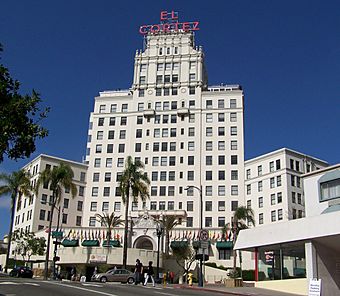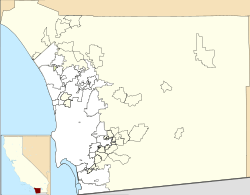El Cortez (San Diego) facts for kids
Quick facts for kids |
|
|
El Cortez
|
|

El Cortez in 2009
|
|
| Location | San Diego, California |
|---|---|
| Built | 1927 |
| Architect | Walker & Eisen; Simpson, William, Construction Co. |
| Architectural style | Mission/Spanish Revival |
| NRHP reference No. | 01001458 |
| Added to NRHP | January 17, 2002 |
The El Cortez is a famous hotel in San Diego, California. It was built between 1926 and 1927. When it opened, it was the tallest building in San Diego.
The hotel sits on a hill at the north end of Downtown San Diego. For many years, it stood out in the city's skyline. From 1927 to the 1950s, it was the most exciting apartment-hotel in San Diego. A large, bright "El Cortez" sign was added in 1937. You could see it from far away at night. In the 1950s, the world's first outside glass elevator was built here. The El Cortez stopped being a hotel in 1978. It was bought by Morris Cerullo for a school. Later, it was saved from being torn down. It became a historic site in 1990 and was added to the National Register of Historic Places in 2002.
Many of the original parts of the building are still there. However, the inside has changed a lot. The El Cortez is 310 feet (94 meters) tall. This makes it the 31st tallest building in San Diego today.
Contents
El Cortez: Early Years (1927-1949)
Building the Hotel
Building the El Cortez started in 1926 and finished in 1927. It cost $2.5 million to build. The 14-story hotel was designed by Albert R. Walker and Percy Eisen. They used a Spanish Churrigueresque style. The building also shows the Spanish Colonial Revival style. The hotel was named after the Spanish explorer Hernán Cortés.
The El Cortez Hotel opened on Thanksgiving Day, November 26, 1927. About 50,000 people came to the opening. This was a huge crowd for San Diego at the time. When it first opened, the hotel had 117 rooms. Most of these were apartments, and 32 were hotel rooms. The Los Angeles Times newspaper said the hotel had a beautiful Spanish garden. It had flowers, green lawns, and fountains.
The hotel's main ballroom was called the Don Room. It was known as one of the most beautiful rooms in the city. It had a fancy carved sandalwood ceiling and a special maple floor. The Aztec Dining Room could seat 200 people. It was also very fancy with big windows. In 1940, the Sky Room was added. It had glass walls and amazing 360-degree views of the city. From the top, guests could see up to 30 miles (48 km) away!
A red neon sign with "El Cortez" was put on top of the building in 1937. Each letter is 12 feet (3.6 meters) high. This sign was made bigger in 1951 and fixed up in 1999. For 36 years, the El Cortez was San Diego's tallest building. Its outside glass elevator, moving walkway, and Starlight restaurant made it a famous San Diego landmark.
El Cortez During World War II
On December 8, 1941, the day after the attack on Pearl Harbor, something special happened. An anti-aircraft battery and radar station were placed on the El Cortez roof. This battery stayed on the roof for the whole war. Soldiers would go through a bar on the top floor to get to the roof. One soldier remembered stepping over tables in his uniform to get outside. He would then climb a fire escape to watch the searchlights at night.
El Cortez: The Handlery Years (1950-1978)
Harry Handlery's Vision
In 1951, Harry Handlery bought the El Cortez for $1.5 million. He loved the hotel so much that he made it his home. Handlery wanted to make it "the finest hotel on the Pacific Coast." He added many new things to attract visitors. In 1952, he added a swimming pool. In 1954, he built the Caribbean wing, which had a large ballroom. The Starlight Room, known for its views, was added in 1956. He also added an outside glass elevator and a moving sidewalk called the Travolator in 1959.
The Glass Elevator and Travolator
Harry Handlery's most famous additions were the world's first outside hydraulic glass elevator and the first moving sidewalk. The glass elevator, called the "Starlight Express," opened in 1956. It took visitors to the hotel's restaurants, offering great city views. Other hotels, like the Fairmont in San Francisco, later copied this design. The glass elevator was a big attraction for the hotel.
Years later, in 1989, there was a debate about the glass elevator. The owner wanted to remove it during renovations. He said there were structural problems and no spare parts. Some people who wanted to save old buildings agreed. They thought the elevator was "fifties kitsch" and didn't fit the original Spanish style. But others felt the elevator was a very important part of the hotel's history. One person said, "It was the elevator that made a night at the El Cortez so thrilling." In the end, the government supported removing the 1950s additions to bring back the original look.
Handlery also built the Travolator bridge in 1959. It connected the El Cortez to his new motel across the street. This moving walkway was designed by Clarence J. Paderewski. Similar designs were later used at airports. Some people didn't like its bright orange color. But in its early days, important people in San Diego used it to go to events at the El Cortez. The Travolator stopped working in 1981. It was torn down in June 1986 because the motel was sold, and the bridge was no longer needed.
Paul Handlery Takes Over
Harry Handlery passed away in 1965. His son, Paul Handlery, took over running the hotel. Some people say that the hotel started to decline after this change. Harry used to check every detail of the hotel himself. Some employees felt Paul didn't spend enough money on fixing up the hotel.
El Cortez: A New Purpose (1978-1981)
In 1978, Paul Handlery sold the El Cortez to Morris Cerullo for $7.5 million. Cerullo was an evangelist, a religious leader. He turned the hotel into a school for evangelism. He also made it the main office for his organization. Cerullo spent about $4 million to change the hotel. He removed many of the fancy meeting rooms and sold the luxury furniture. The living areas became dorms for students.
Cerullo only needed about half of the hotel's 550 rooms for his students. The other rooms were still open to the public. He tried to reopen the Don Room, but it closed again quickly. In early 1981, Cerullo put the hotel back up for sale. It was sold several more times in the 1980s and 1990s.
El Cortez: Later Years
New Plans and Challenges
In 1983, a group called El Cortez Associates bought the hotel. They suggested it as a place for the new San Diego Convention Center. But the city decided to build the convention center somewhere else. After this, there were ideas to fix up the El Cortez using city money. But these plans didn't happen. The hotel was empty and stripped of its furnishings. The El Cortez was then sold to the Grosvenor family. For a short time in 1984 and 1985, a theater group put on plays in the Don Room.
Saving a Landmark
By 1989, the El Cortez was in a sad state. The Los Angeles Times wrote that it had been mostly empty for almost ten years. Its famous neon stars no longer shined. Its beautiful wooden doors and brass fixtures had been sold. In 1989, a Japanese company bought the hotel. They planned a huge project to renovate the El Cortez. But in 1990, they thought about tearing it down instead.
People who wanted to save historic buildings stepped in. They successfully had the El Cortez declared a San Diego historic site in 1990. This stopped it from being demolished. Later, the new owners got the hotel listed on the National Register of Historic Places. This helped them get money to fix it up.
Becoming Condominiums
By the late 1990s, the El Cortez looked run down. In 1999, developers got a loan to renovate the building. They restored some of its historic parts. At first, they rented out the units as fancy apartments. But in 2004, they changed the building into condominiums. It was divided into 85 homes, plus some shops and offices. The beautiful Don Room was also restored.
By 2007, there were problems like bursting pipes. The value of the homes also went down. This led to disagreements between the homeowners and the developers. Some homes were taken back by lenders and sold for much less than their original price.
El Cortez: Its Impact
Many famous people have stayed at the El Cortez. These include U.S. Presidents Dwight D. Eisenhower, Lyndon B. Johnson, and Gerald Ford. Singers like Bing Crosby, Elvis Presley, and Roy Rogers also visited. The hotel was even shown in the 1963 movie A Ticklish Affair.
On July 25, 1990, the City of San Diego's Historic Site Board said the building was "historic." This important decision saved it from being torn down. Because of this, the inside of the building was fixed up for modern apartments. The El Cortez Hotel was added to the National Register of Historic Places on January 17, 2002. This was because of its important role in architecture and engineering.
Images for kids
See also
 In Spanish: El Cortez Apartment Hotel para niños
In Spanish: El Cortez Apartment Hotel para niños






